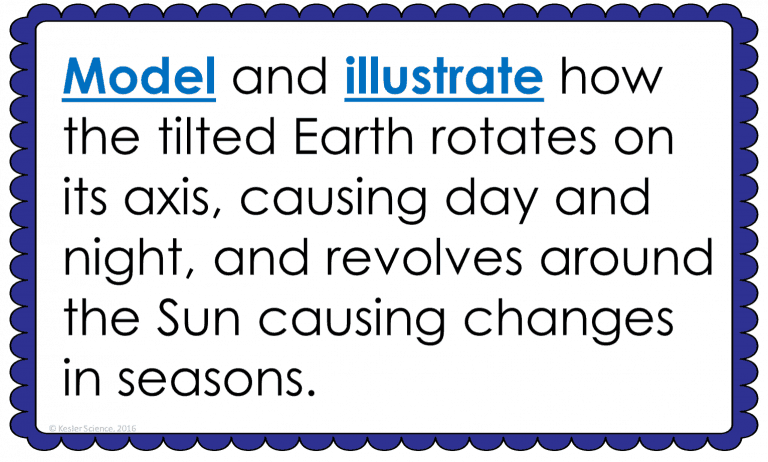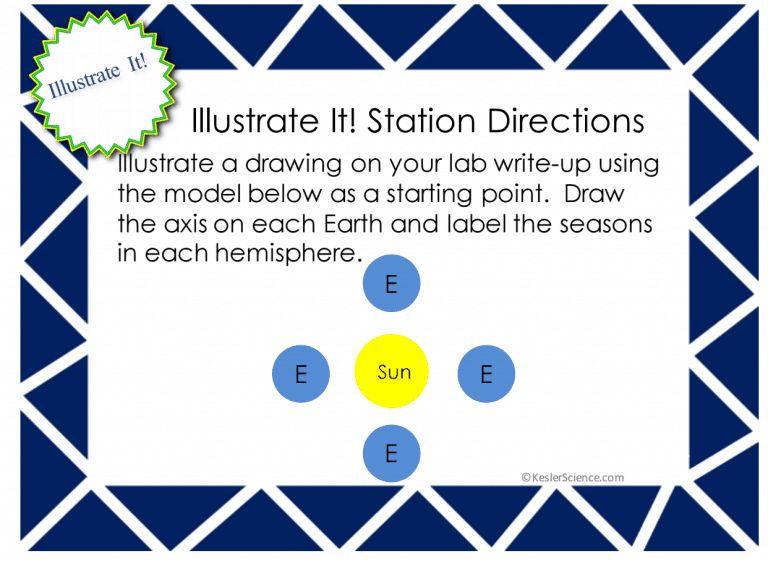Seasons Lesson Plan - A Complete Science Lesson Using the 5E Method of Instruction
At the end of this comprehensive seasons lesson plan students will be able to model and illustrate how the tilted Earth rotates on its axis, causing day and night. They will also be able to demonstrate how the revolution of the Earth around the Sun causes the change in seasons in both the northern and southern hemisphere. Each lesson is designed using the 5E method of instruction to ensure maximum comprehension by the students.
The following post will walk you through each of the steps and activities from the seasons lesson plan.
Engagement
At the beginning of the lesson the class will discuss the objectives and some of the relevant vocabulary using the included objective statements and word wall cards.

The engagement activity continues with a with a short skit. Five different students will be asked to read the script. The script has some students sitting around talking about why we have different seasons on Earth. Each of the characters has a differing opinion, and the class will be asked which one they most agree with. The catch is that none of the students are entirely correct and it will make for a great class discussion prior to beginning the rest of the lesson on why we have seasons.
Estimated Class Time for the Engagement: 20-30 minutes
Exploration
A student-centered station lab is setup and the class will begin to explore why we have seasons and what causes them. There are eight stations in the lab. Four of the stations are considered input stations where students are learning new information about why we have seasons, and four of the stations are output stations where students will be demonstrating their mastery of the input stations. Each of the stations is differentiated to challenge students using a different learning style. You can read more about how I setup the station labs here.
Explore It!
Students will be building a model of the Earth and Sun to learn about why we have different seasons as the Earth revolves around the Sun. This station is setup to get students to explore the different positions of the Earth around the Sun and shows how the tilt of the Earth is the determining factor for why seasons happen at different times throughout the year.
Watch It!
At this station students will be watching a four minute video about the rotation and revolution of the Earth. There are 3 questions relating to the content which students will need to answer on their lab sheet.
Research It!
The research station will allow students to get online and manipulate a computer model of the Earth’s revolution around the Sun and how it impacts the direct and indirect sunlight on different points on our planet. A series of questions will guide them through the activity as they begin to build a deeper understanding of why we have different seasons.
Read It!
This station will provide students with a one page reading about what the Earth would be like with no seasons. Students are asked four questions about the reading and will begin to understand that the tilt of the Earth on its axis is why we have seasons at different times throughout the year.
Assess It!
The assess is station is where students will go to prove mastery over the concepts they learned in the lab. The questions are setup in a standardized format with multiple choice answers. Some of the questions will have students looking at diagrams to determine the season. Other questions will discuss the length of daylight hours during different seasons, and a hypothetical question about what could be the cause if we stopped having seasons all together.
Write It!
Students who can answer open-ended questions about the lab truly understand the concepts that are being taught. At this station the students will be answering three questions regarding why we have seasons, the average length of day and night, and why it’s hotter in the summer and colder in the winter.
Illustrate It!
Your visual students will love this station. Students will be drawing a diagram of the relationship between the Sun and Earth throughout the year. They will be labeling each season in both the northern and southern hemisphere.

Organize It!
The organize it station allows your students to use a manipulative to ensure their understanding of the the different seasons as the Earth rotates around the Sun.
Estimated Class Time for the Exploration: 1-2, 45 minute class periods
Explanation
The explanation activities will become much more engaging for the class once they have completed the exploration station lab. During the explanation piece the teacher will be clearing up any misconceptions about day/night and seasons with an interactive PowerPoint, anchor charts, and interactive notebook activities.
This seasons lesson includes a PowerPoint with activities scattered throughout to keep the students engaged.
The students will also be interacting with their journals using INB templates for seasons and day/night. Each INB activity is designed to help students compartmentalize information for greater understanding of the concept.
Estimated Class Time for the Exploration: 2-3, 45 minute class periods
Elaboration
The elaboration section of the 5E method of instruction is intended to give students choice is how they prove mastery of the concept. When students are given choice the ‘buy-in’ is much greater than when the teacher tells them the project they will have to create. Each of the seasons projects will allow students to explain day/night, why we have seasons, and the length of day/night during each of the four seasons.
Estimated Class Time for the Elaboration: 2-3, 45 minute class periods (can also be used as an at-home project)
Evaluation
The final piece of the 5E model is to evaluate student comprehension. Included in every 5E lesson is a homework assignment, assessment and modified assessment. Research has shown that homework needs to be meaningful and applicable to real-world activities in order to be effective. When possible, I like to give open-ended assessments to truly gauge the student’s comprehension.
Estimated Class Time for the Elaboration: 1, 45 minute class period
Download Over $100 in FREE Resources
For Middle School Science
Simply create a login below and gain immediate access to a selection of our Kesler Science product line worth $100 - for FREE. There's a full version of every product type! You'll also join tens of thousands of middle school science teachers who receive timely tips and strategies straight to their inbox.





